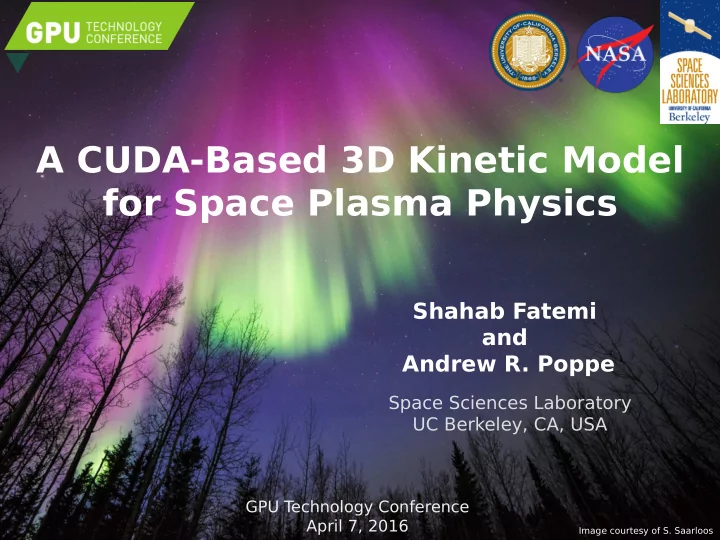

A CUDA-Based 3D Kinetic Model for Space Plasma Physics Shahab Fatemi and Andrew R. Poppe Space Sciences Laboratory UC Berkeley, CA, USA GPU T echnology Conference April 7, 2016 Image courtesy of S. Saarloos
[NASA] Plasma is the fourth state of matter. Highly ionized gas, often >100,000 Kelvin. Mainly consists of electrons and ions (charged particles). Solar wind (supersonic fmow of plasma from the Sun) typical speed near Earth: ~400 km/s (~895,000 mi/h) 2
Solar wind plasma interacts with difgerent objects in difgerent ways. Mars Earth [Artistic work: NASA/GSFC] 3
A visual proof for solar wind interaction with the Earth: Northern lights (aurora) [ C a n a d a . P h o t o g r a p h e r : D a n i e l J . C o x / C o r b i s ] Aurora on Jupiter, but not visible by eye (Ultra Violet). [John Clarke (University of Michigan)] 4
Why are these important? Solar wind interaction with the Earth impacts our daily life. Astronauts, and spacecrafts in space, and their safety. Fundamental information on the history of planetary evolution Mars has lost most of its atmosphere through interaction with solar wind plasma. Space weather monitors solar activity. Solar wind has been interacting with the Earth over billions of years, since the Earth was born. 5
Modeling/Simulations In-situ observations [STEL, Nagoya University] [NASA/New Horizons] Lab experiments 6 [Vacuum chamber/University of Colorado]
Modeling techniques Magnetohydrodynamic (MHD) Fluid For global scale simulations Hybrid (Kinetic-Fluid) Similar to PIC models For medium scale simulations Boltzmann-Vlasov Kinetic Particle-in-cell (PIC) For small scale simulations 7
Motivation Major problems in HPC in space and plasma physics: Network latency (communication) Processor load imbalance (source and loss processes) High cost to maintain super computers CPU performance HPC using CPUs in space and plasma modeling has reached a state that cannot satisfy all our needs. We need to use new technologies. We need GPUs! 8
Kinetic-particle method Similar to n-body problems. Move charged particles. Solve electromagnetic (wave) equations. 9
Our GPU-based kinetic model In our implementation, we use Single-CPU Single-GPU 10
Plasma motion Concept of plasma motion is difgerent than neutral atoms and thermal gases. 11
Particle mapping to grid 12
Performance (naïve implementation) Grid size: 100x100x100 Particles per cell: 64 (total: 64M particles) 13
Particle mapping to grid Particles are marked in every block of particles. A thread-block is assigned to a block of particles. Particles are sorted as they move between grid cells. 14
Comparison Grid size: 100x100x100 Particles per cell: 64 (total: 64M particles) Function Naïve (ms) Advance (ms) Speed up Particle motion 46.6 38.4 ~1.20 Particle mapping 261.7 189.6 ~1.38 Field mapping 187.3 84.9 ~2.20 Atomic operations are not all that bad! 15
Application 1 Plasma interaction with Ganymede (the largest moon in our solar system) Moon Ganymede Earth 16
Fair Comparison A fair comparison is always a challenge! We made two identical simulation runs (identical grid cells, particle number, time steps) Run #1) 288 Intel processors (6 nodes x 48 CPUs) Without GPUs Run #2) 1 Intel processor + single Titan X GPU. Speed up: Cost not included Model Run time (h) Cost ($) 158/124 =1.27 CPU-based ~158 ~(60K?) Cost included GPU-based ~124 ~1K 158*60/124 = 76 Be fair and keep developing! 17
Application 2 Real-time simulation of plasma interaction with Mars. Mars Video here! 18
Summary The fjrst GPU based 3D kinetic model in space and plasma. New algorithms introduced in our model. We can now take a step forward to solve more complex problems. Future work: Implement a multi-GPU model Improvement in our algorithms 19
Field Solver We use fjnite difgerence approximation to solve our electromagnetic equations. 21
Recommend
More recommend